Learning Stories
Through inquiry-based learning, we witness our learners’ journey unfold, each step marked by curiosity, exploration, and profound discovery. This documentation of learning stories shows their evolving understanding of the world, capturing their triumphs, insights and growth milestones.
Big Idea: People use their “Hundred Languages“ to express themselves
Our learners at Mountbatten 223 explore the big idea of using “100 languages” to express themselves.
So what is the “100 languages”?
![]()
The child
is made of one hundred.
The child has
a hundred languages
a hundred hands
a hundred thoughts
a hundred ways of thinking
of playing, of speaking.
A hundred always a hundred
ways of listening
of marveling of loving
a hundred joys
for singing and understanding
a hundred worlds
to discover
a hundred worlds
to invent
a hundred worlds
to dream.
The child has
a hundred languages
(and a hundred hundred hundred more)
but they steal ninety-nine.
The school and the culture
separate the head from the body.
They tell the child:
to think without hands
to do without head
to listen and not to speak
to understand without joy
to love and to marvel
only at Easter and Christmas.
They tell the child:
to discover the world already there
and of the hundred
they steal ninety-nine.
They tell the child:
that work and play
reality and fantasy
science and imagination
sky and earth
reason and dream
are things
that do not belong together.
And thus they tell the child
that the hundred is not there.
The child says:
No way. The hundred is there.
Loris Malaguzzi (translated by Lella Gandini)
The poem points out that school and culture rob the children of their rights to learning in different ways and expressing in a variety of “languages”. With the image of educators as researchers, they will embark on a journey to find out how children can express themselves in a ‘100 languages’ and what are the different “languages” they would use.
With Earth Day coming up, the educators use books, different narratives and provocations to spark interests among the children. The educators introduce children to recycled materials and the idea of reusing, reducing and recycling.
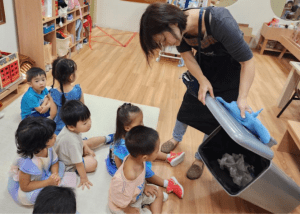
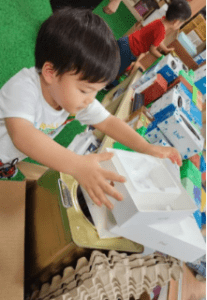
During circle time, the educators, together with the children, share ideas about the possibility of creating ‘things’ from recycled materials.
Miss E: Ah! I can use this cardboard to replace our basket outside (used to put hand sanitiser, torchlight, a packet of wet wipes and thermometer).
Jamie: I want to make an aeroplane!
Several other children also respond to his idea;
I want to make an aeroplane too.
I want to make a race car!
I want to make an airport!
I want to make a fairy!
I want to make a bus.
Inquiry Project: What can we make with different (recycled) materials?
- What is the shape of the wing of an aeroplane?
A group of children decided to make use of the recycled materials they had picked out from our Gurung Kuni Recycling Centre to construct an aeroplane.
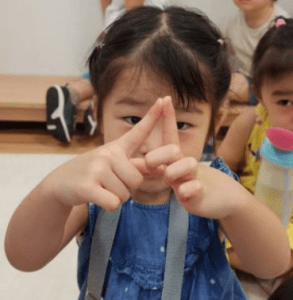
It is like a triangle.
It is like the fan!
I think it is like a rectangle.
By observing the children and listening to them, we started small research to find out the shape of the wing of an aeroplane.
A child remembers that there are some aeroplane models in the TE+D (Technology, Engineering + Design) space and off we went.
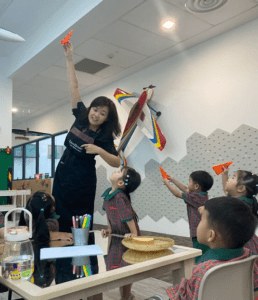
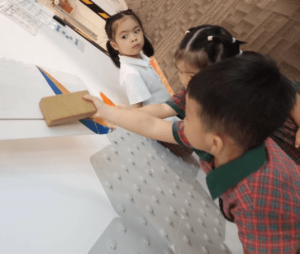
Children make use of the materials offered to interpret and express their ideas about the shape of the aeroplane wings.
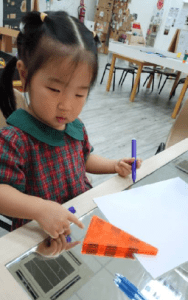

Rectangle!
Triangle!
Big and small.
Straight over here.
Pointy here.
Back in the classroom, an area has been set up for the children to explore the characteristics of recycled materials such as cardboard, plastic and cloth. The educator proposes using their drawings to start creating a 3D model of their planes. The proposal is done with the intention to introduce children to the idea of planning and reflecting, to build the habit of thinking before acting, and to promote thinking skills.
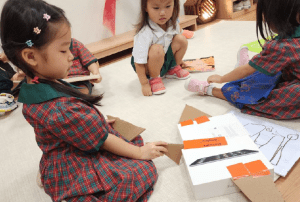
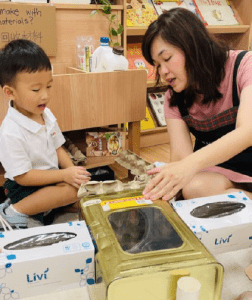
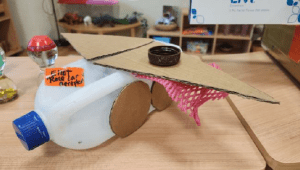
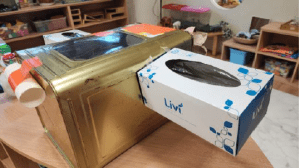
The tissue box is a rectangle.
The aeroplane wing is a triangle.
There are 2 big wings and 2 small wings. And the body.
Concurrently, another group of children took interest to the car. A separate investigation began….
- What can you see on a car?
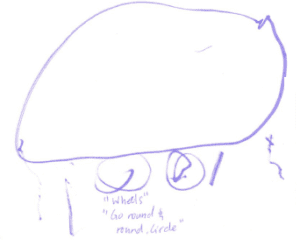
Wheels. Go round and round. Circle.
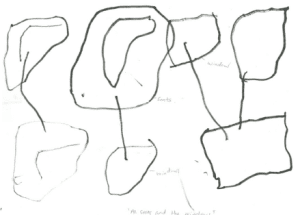
All seats and windows here.
Another group of children displays interest in making race cars and sports cars. We began to wonder;
- What is the difference between a race car, sports car & ‘normal’ car?
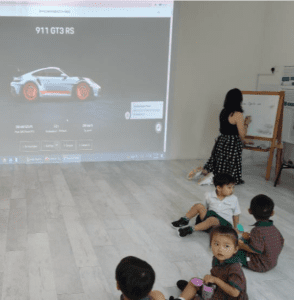 In TE+D – Using 3D image
In TE+D – Using 3D image
| Race Car | Sports Car |
| I can see on a race car road. It is a race car track. It has fins. Race car has wings Wing is pointing backwards. It has a long nose. | Sports car can drive super fast. |
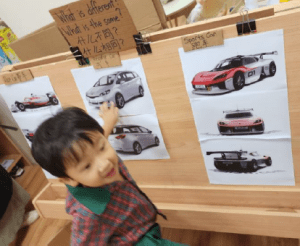
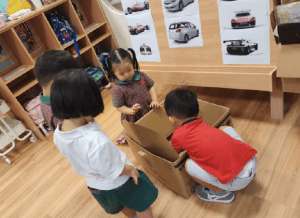
In the Classroom – Using Photos & 3D Structures
The investigation continues in the Atelier where our Atelierista, Miss Afiqah extended the children’s knowledge of the wheels using toy cars and recycled materials.
Miss A: What happens when I take away one wheel? How about two wheels?
The children experiments with removing and putting on the wheels on the toy cars to explore the concept of stability.
Recycled materials such as paper rolls, bottle caps, bottle lids, popsicle sticks and straws were presented to invite children to create their own cars.
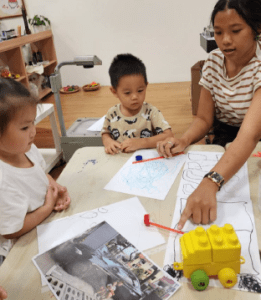
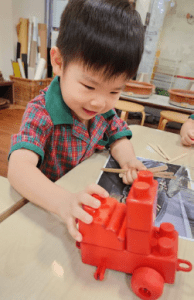
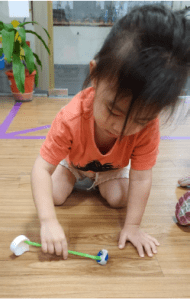
In the Atelier – Using Toy Cars & Recycled Materials
Language of Blocks
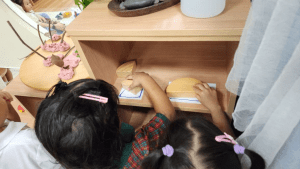
A designated wooden blocks area was set up in the classroom for children to use as a way to express themselves. Through the meaningful interactions between the adults and peers, children learnt the concept of shapes when sorting the blocks, the concept of stability and balance when stacking the blocks, and the concept of gravitational force when observing cars rolling off the ramps.
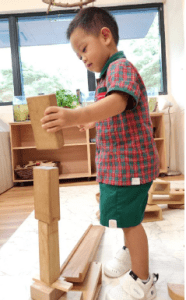
Make taller and taller! – Takes more blocks to stack
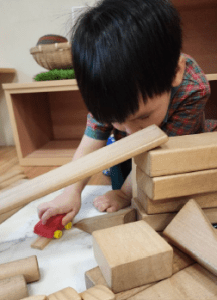
A tunnel! – Uses a toy car to go through the structure
Language of Clay
Clay is a material that is easily malleable and full of possibilities. Its properties allow children to manipulate it in many ways, which encourages creativity and imagination.
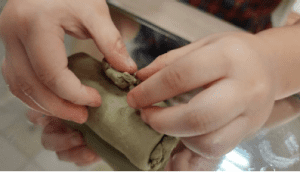 Circle for the wheels.
Circle for the wheels.
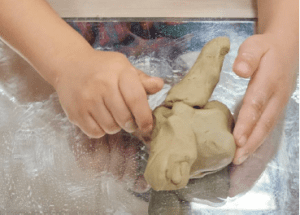 My fighter jet.
My fighter jet.
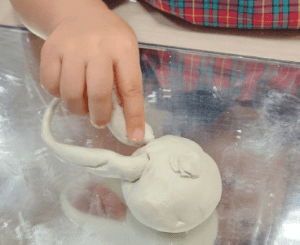
Handbag for mummy.
A child’s daily experiences can all be represented.
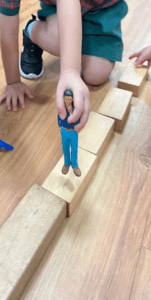
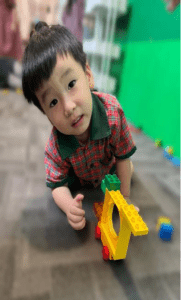
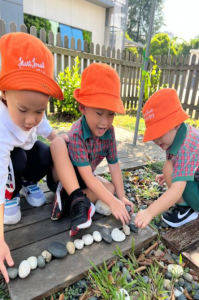
Our children use different “languages” to make symbolic representations of their mental images.
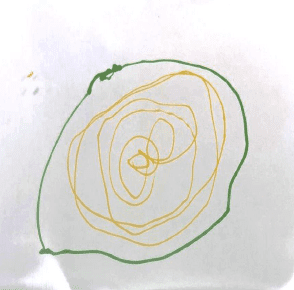 Spiralling slide
Spiralling slide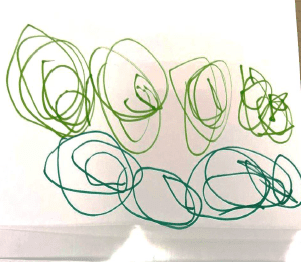
Walking on the road
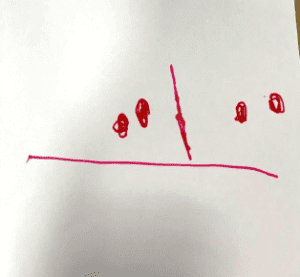
Train and swing
Our children express their ideas and thoughts through the unique characteristics of the materials that are intentionally offered by the educators.
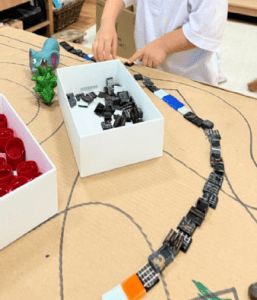 This is my daddy’s car on the road.
This is my daddy’s car on the road.  The race car is turning!
The race car is turning!
After weeks of exploration to identify different ways to express ideas and thoughts, our educators wonder if children are aware of their mental thoughts and how they can make people around them understand them – the concept of perspective-taking.
How do we express our ideas and thoughts in different languages so that others understand us?
“Studies have shown that young children ages three to six have the mental skills to make thoughtful decisions about their behaviour and actions. It is a time when we can start to develop metacognition – the higher-level thinking and problem-solving skills by encouraging children to reflect, predict, question, and hypothesise.”
In order for the children to become more aware of their thoughts, adults can engage the children in conversations using a variety of communication strategies such as prompts and open-ended questions to encourage them to extend their thinking and learning.
Our educators will continue to use interactions, the environment and learning experiences to encourage children to think about their mental thoughts, e.g. what they would like to draw, make or say before expressing them, to build the habit of planning and to reflect on promoting thinking skills.
Our Nursery 2 children’s inquiry began with a meaningful conversation around Earth Day—a time when we reflected together on how we can care for the planet. As we explored ideas on protecting the Earth, the children became particularly interested in the concept of recycling. What does it mean to recycle? What can be recycled? Why is it important?
During one of our class discussions about reducing paper wastage, the children began to wonder where paper come from and if we could make our own paper. The journey then began on using unwanted paper to make new paper, which extended to experimenting with different types of paper.
To evoke interest and further investigations, a demonstration was done for the children on making recycled paper using unwanted paper. The children were very excited to make use of the new tools and equipment (blender and sieves) and were engaged in the demonstration as well as the hands-on opportunities throughout the process.



It’s blue! – Geraldine
Looks like swimming pool! – Ryan
I want to touch it! – Naira
So loud! – Cedric
Looks like water! – Evan
They embarked on a hands-on exploration using different kinds of used paper to try recycling it themselves. Through this process, they discovered that not all paper could be recycled in the same way—and that different types of paper produced different results. The journey began to compare the similarities and differences of the paper used, while experimenting with changes in the process.
Drawing Paper
The children were curious to draw on the recycled paper, making connections to tearing the unwanted drawing paper and turning them into ‘new’ paper which could be used to draw again.

I make a hole. – Geraldine
I can draw on it! – Jamie
Egg Cartons (Cardboard)
The children were invited to tear the egg carton and blending them into a pulp with water. With their prior experience of tearing drawing paper the day before, they began to make comparisons and gained new knowledge.


Harder to tear. – Jamie
Become soft. – Kaelyn
Look like coffee! – Elliot
Look like muddy puddle! – Everett
Magazine Paper
Our investigation continued with magazine paper. New processes and tools were introduced to make “paper without holes” and “make a rabbit”, as proposed by the children.



The children proposed shaping the recycled paper into forms such as hearts, circles, stars, and more, as well as adding dried flowers and leaves. They began experimenting with ways to make this possible.

The journey continues as the children explore, experiment and make new discoveries.

How about blending the flowers and leaves with paper?

What happen if we didn’t add water?
This discovery sparked a deeper curiosity: What else can be recycled besides paper? Their interest expanded to food waste recycling, an area they had not explored before. They were intrigued to learn that leftover food could also be recycled —and during a learning journey to a food waste recycling facility, they were even more fascinated when they found out that black soldier fly larvae are nature’s very own food waste recyclers.
This led to a new phase of the inquiry.
The children recorded their observations through mark-making. While making new discoveries about what was in the tank, they simultaneously honed their fine motor skills, hand-eye coordination and observation skills.
What can you see? Draw them!
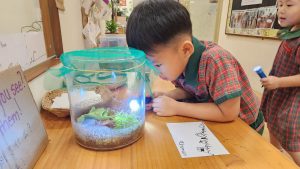
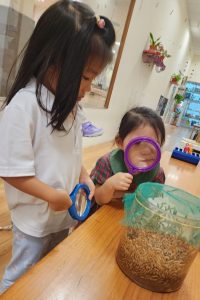
Making use of all senses.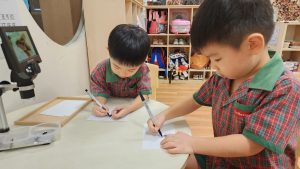
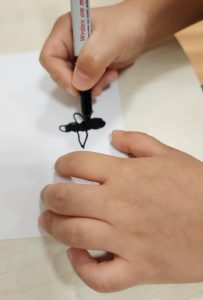 Using a digital microscope to amplify the details on the larvae.
Using a digital microscope to amplify the details on the larvae.

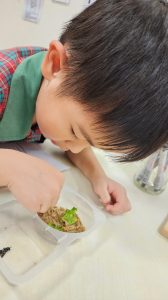
An invitation for closer observation.
A Learning Journey to a Food Waste Recycling Facility
After weeks of exploration and observation, the children went on a learning journey to Ento Industries – a food waste recycling facility at Tuas which uses the black soldier fly larvae to recycle food waste.
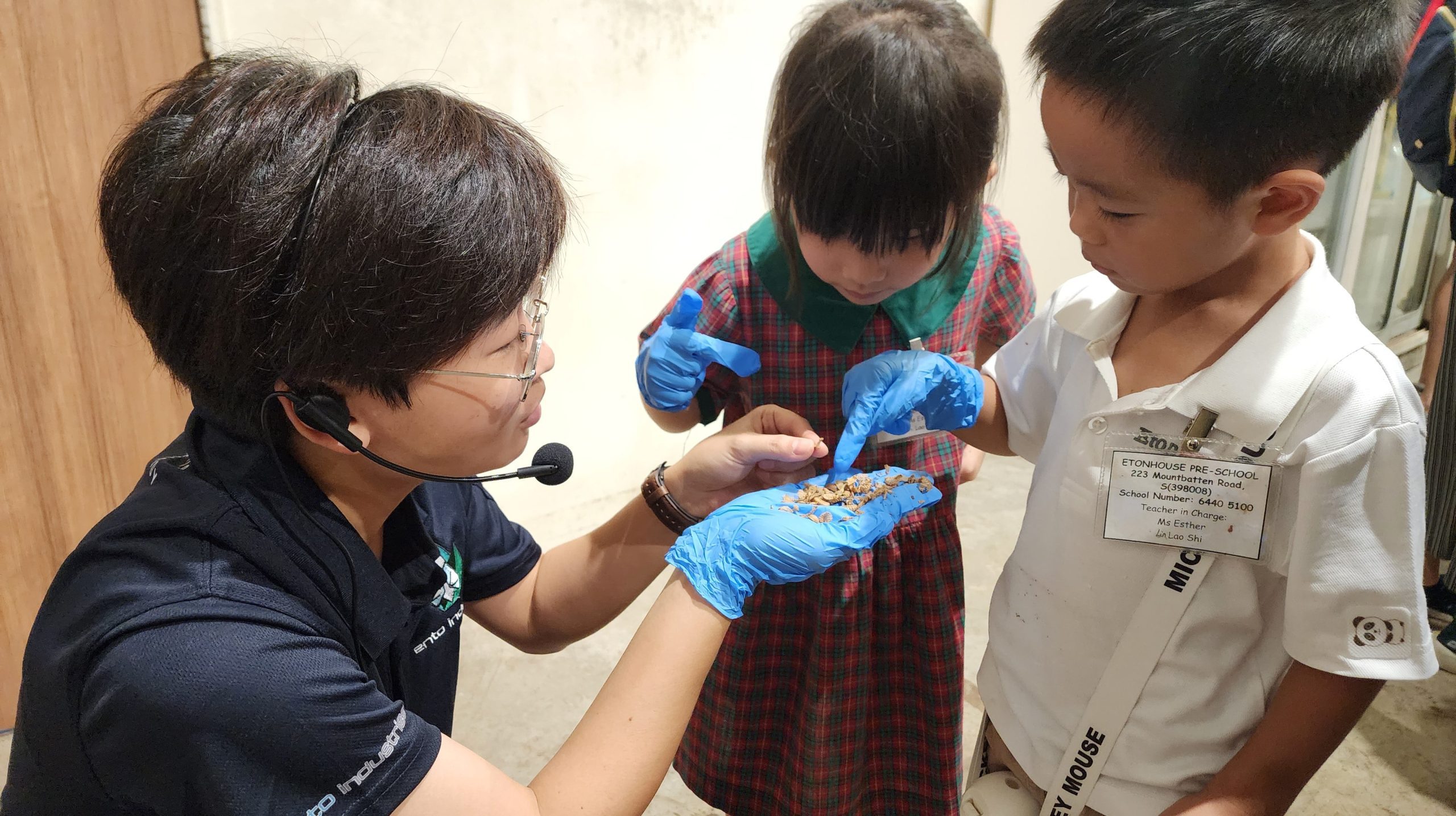
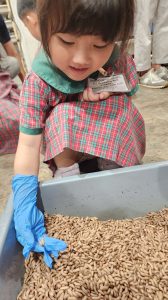
They are not worms, they are the ‘babies’ of Black Soldier Flies!
Our children observed and recorded the growth and life cycle of the larvae, documenting their observations through drawings, discussions, and questions. They explored what the larvae ate, how they changed over time, and how they helped reduce food waste.
Using the leftover food from lunch and food scraps from the kitchen (e.g. apple skin), the children experienced feeding the black soldier fly larvae and observed the changes that took place.


Feeding the larvae with leftover chicken meat and pumpkin
What began as a simple discussion about Earth Day grew into a rich, child-led investigation into materials, sustainability, life cycles, and ecological responsibility—highlighting the children’s natural curiosity, their capacity to wonder, and their role as thoughtful stewards of the environment.